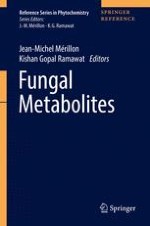2017 | OriginalPaper | Chapter
16. Pigments and Colorants from Filamentous Fungi
Authors : Yanis Caro, Mekala Venkatachalam, Juliana Lebeau, Mireille Fouillaud, Laurent Dufossé
Published in: Fungal Metabolites
Publisher: Springer International Publishing
Activate our intelligent search to find suitable subject content or patents.
Select sections of text to find matching patents with Artificial Intelligence. powered by
Select sections of text to find additional relevant content using AI-assisted search. powered by
